Contents
Planting and caring for fieldfare can enrich the garden with a very beautiful and spectacular plant. But in order for the fieldfare to please with rapid growth and abundant flowering, you need to know the rules for caring for it.
Description of the rowanberry
Rowan-leaved fieldfare is a shrub of medium height that grows wild mainly in China, Siberia, Japan and Korea. The plant is quite easy to confuse with mountain ash, but fieldfare is much more decorative, for which gardeners appreciate it.
What does a fieldfare look like
In the wild and in cultivated plantings, fieldfare is a shrub up to 3 m tall with numerous straight shoots and a very spreading crown. Fieldfare family – Pink, the trunks of old shoots of the plant are brownish-gray and lignified, young shoots are green and with a thin edge. Attention is drawn to the leaves of the rowan-leaved shrub, it is to them that he owes his name. Large, up to 25 cm each, lanceolate in shape, they look like ordinary rowan leaves.
During the growing season, the rowan-leaved shrub changes the color of the foliage several times. When blooming, its leaves are pale pink, then quickly become light green, and in autumn they turn yellow or dark red. At the end of June, the plant blooms profusely with white small flowers collected in pyramidal panicles up to 30 cm each. The petals of the flowers are half as long as the stamens, and flowering continues for a month.
Fieldfare height
The growth of a shrub directly depends on the quality of the soil and the correct care. On average, fieldfare reaches 1,5-3 m in height.
Rowanberry crown diameter
In the photo of the fieldfare bush, you can see that its bright feature is a wide and voluminous crown. The bush of a rowan-leaved plant can spread up to 1,5-3 m wide.
How fast does fieldfare grow
It is convenient to plant a plant in a summer cottage, since the mountain ash shrub is characterized by rapid growth – up to 40 cm per year. True, this forces the plant to be pruned more often, but when creating artistic compositions, one does not have to wait long for the fieldfare to enter full decorativeness.
The life span of a shrub is about 50 years. Therefore, rowan-leaved shrubs can delight with their flowering for a very long time.
Fieldfare varieties
Basically, only 5 varieties of shrubs are cultivated in summer cottages. Each of the types of rowan-leaved fieldfare has its own advantages and characteristics.
Rowanberry rowanberry
The “classic” variety, which is most popular with gardeners. It usually does not exceed 2 m in height, the crown consists of pointed leaves about 20 cm long, the shrub blooms with long light cream flower panicles. The advantages of the rowan-leaved shrub include its unpretentiousness and increased frost resistance and, of course, a decorative appearance, as well as a fragrant aroma during flowering.
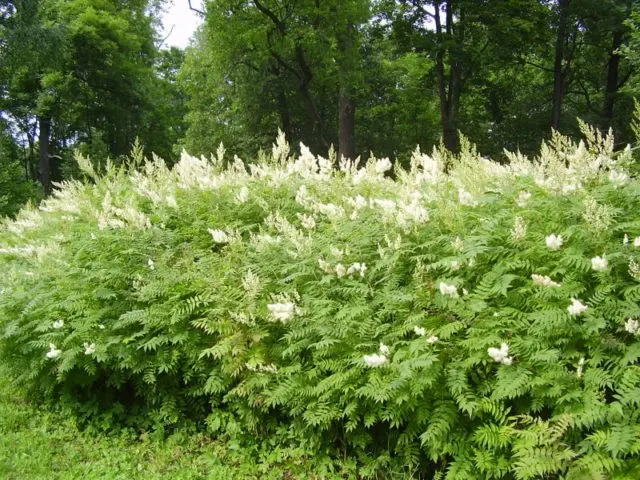
Fieldfare Pallas
A shrub of this variety in its natural form can most often be found in Transbaikalia and Siberia. It is cultivated throughout the country, the plant reaches an average height of about 1,2 m. Distinctive features of the rowan-leaved fieldfare Pallas are its powerfully developed roots, which help the plant tolerate temporary drought well, and high resistance to cold. Fieldfare Pallas blooms with lush beautiful panicles of white or pinkish-cream color and looks great both in compositions and in single plantings.
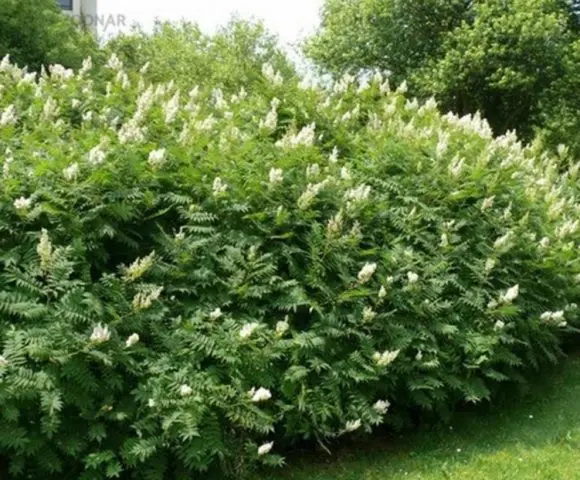
Fieldfare Sam
The most decorative of the varieties of rowan-leaved fieldfare. The shrub of this variety can reach 0,8-1 m in height, has beautiful small leaves of light green color with a slight bronze tint, this feature is noticeable in the photo of the fieldfare plant. Variety Sam blooms with long cream panicles, consisting of small flowers.
Fieldfare cultivar Sam grows more slowly than other varieties of the plant, and its maximum height is not that great. Therefore, the plant is often used to create hedges in the garden or as a middle tier for artistic compositions.
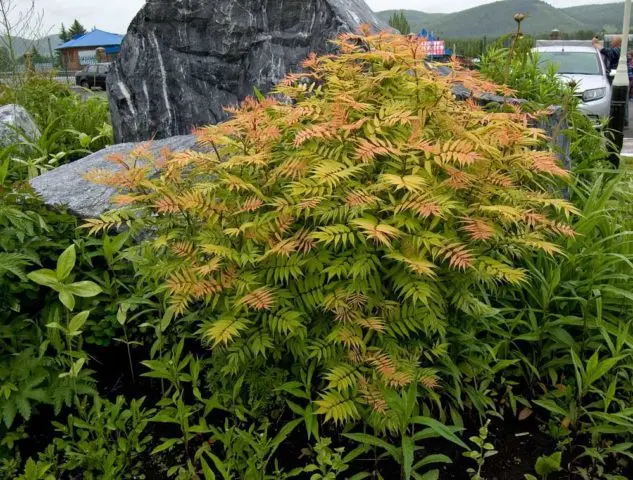
Fieldfare tree
This variety naturally occurs in Southeast Asia and can reach 6 m in height – more than other varieties of the plant. The variety blooms a little later, in July or August, but still pleases the eye with lush white and cream inflorescences, consisting of small flowers.
Tree fieldfare has high frost resistance and successfully grows in regions with a harsh climate.

Fieldfare felt
Another variety of fieldfare from East Asia is the felted fieldfare. The plant is also characterized by high growth up to 6 m and prefers to grow on rocky mountain slopes. Felt fieldfare has a reduced frost resistance, but tolerates a lack of moisture quite well. However, it is rarely used in landscape design, the fact is that the variety lacks beautiful flowering.

Planting and caring for fieldfare in the open field
Growing and caring for fieldfare in a summer cottage is quite simple, the plant makes low demands and tolerates difficult climatic conditions well. To successfully plant a shrub, it is enough to know the basic rules of cultivation.
Preparation of planting material
Rowan-leaved shrubs in a summer cottage are usually grown from a seedling purchased at a gardening market. The planting material does not need special preparation, the seedling is transplanted immediately into the ground to a permanent chosen place.
Preliminary measures are that all dry and damaged branches must be removed from the purchased seedlings. The remaining shoots can be cut to 15 cm so that 2-4 buds remain on each of them.

Site preparation
The shrub is extremely unpretentious and tolerates almost any growing conditions. As a site for a shrub, both sunny and shaded places are suitable.
The nutritional value of the soil is also not of particular importance. However, the plant feels best on fertile loams with neutral or weak acidity with an index of about 6-7. Also, the soil should pass oxygen well enough to improve its quality, you can dig up the site and add some peat and sand to the soil.
Fieldfare planting
The optimal time for planting rowan-leaved fieldfare is early spring. At the same time, young seedlings do not need warming, even if return frosts may still occur soon. As a rule, in the wild, the shrub grows in places with rather strong temperature differences, and the cold does not pose a particular danger to it.
- A planting hole for fieldfare must be dug shallow, but wide enough, since the shrub is prone to rapid and strong growth. Usually, the depth of the pit is about 40 cm, and it is expanded up to 80 cm.
- A substrate of sand, humus and soddy soil, mixed in a ratio of 1:2:1, is poured into the planting hole. You need to fill the soil so that a mound forms in the pit.
- On top of this mound, a seedling of rowan-leaved shrubs is installed, its roots are carefully straightened, and then the hole is covered with earth to the end, flush with the surface.
Immediately after planting, the soil in the trunk circle should be watered abundantly, and then mulched with peat or pieces of bark so that the moisture does not evaporate too quickly.
Watering and top dressing
The plant can tolerate a short drought, but it needs a lot of moisture on an ongoing basis. When growing fieldfare, waterlogging of the soil will be better than a lack of water. Therefore, it is recommended to water rowan-leaved shrubs often and abundantly, especially in the first year after planting in open ground.
In subsequent years, you need to add water under the roots of the plant 2-3 times a month, and in hot weather – every few days. The rowan-leaved shrub perceives spraying well, but it is necessary to sprinkle the leaves and shoots with water early in the morning or after sunset, when the hot sun’s rays can no longer burn the plant.
Rowan-leaved fieldfare is a shrub with a very wide and developed crown. Therefore, the plant must be fed regularly for healthy growth. The shrub well perceives both mineral dressings and organics. It is recommended to fertilize it with nitrogen substances in spring, potassium nitrate in summer, and superphosphate in autumn. During the warm season, compost, peat or humus can be applied under the bush.
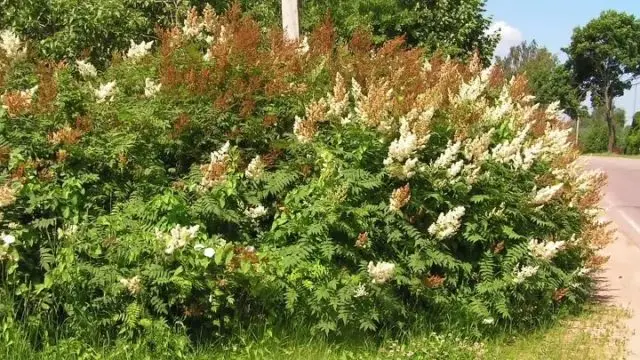
Pruning fieldfare rowanberry
Rowan-leaved fieldfare grows very quickly and at the same time expands widely in breadth. Therefore, caring for fieldfare in spring and summer includes a mandatory haircut. Otherwise, the shrub will lose its decorative shape and, moreover, will begin to interfere with plants located nearby.
- The first pruning is usually carried out 3 years after planting the seedling. You need to prune first of all diseased, dry and broken branches.
- They also remove shoots creeping along the ground, and cut off branches growing outside the crown projection.
- When pruning, it is necessary to remove the root growth, which grows especially often and violently in the rowan-leaved fieldfare. It not only violates the decorative forms of the shrub, but also takes away nutrients from the plant.
You can cut the fieldfare very often, it tolerates pruning well and recovers quickly. If the plant is used as a hedge, then you can cut it up to 4 times per season – this does not cause harm, but it allows you to maintain beautiful outlines.
Fieldfare transplant
A rapidly growing fieldfare from time to time requires a transplant. It is usually carried out every 2-3 years, and the algorithm is as follows.
- In a free area suitable for growing fieldfare, they dig a landing hole of standard sizes, equip drainage at its bottom and prepare nutrient soil consisting of soddy soil, compost and humus.
- The overgrown fieldfare is carefully dug up in the old place, and then its rhizome is divided into several parts, each division should have healthy strong shoots and developed intact roots.
- To avoid rotting, sections of all divisions are treated with ash or a biostimulant, and then the fieldfare is planted in prepared holes.
After transplanting the fieldfare in the spring, the ground around the new rowan-leaved shrubs should be slightly compacted and poured abundantly with at least 20 liters of soft settled water.
Preparation for winter
Rowan-leaved fieldfare is a plant that, under natural conditions, is accustomed to cold weather, sudden frosts and sudden temperature changes. The frost resistance of the shrub is high, therefore, even in Siberia, and even more so in the middle lane, it does not need additional winter shelter.
However, in autumn, after flowering, it is recommended to remove all flowers still remaining on the shoots. After leaf fall, it is necessary to carefully collect the leaves from the area where the fieldfare grows and burn them. This will not allow pests and fungal microorganisms to appear in the roots of fieldfare.
How to propagate rowanberry
Since the shrub grows and develops very quickly and powerfully, it is not necessary to buy new seedlings to increase the fieldfare population on the site. It is much easier and more convenient to use one of the vegetative methods of plant propagation.
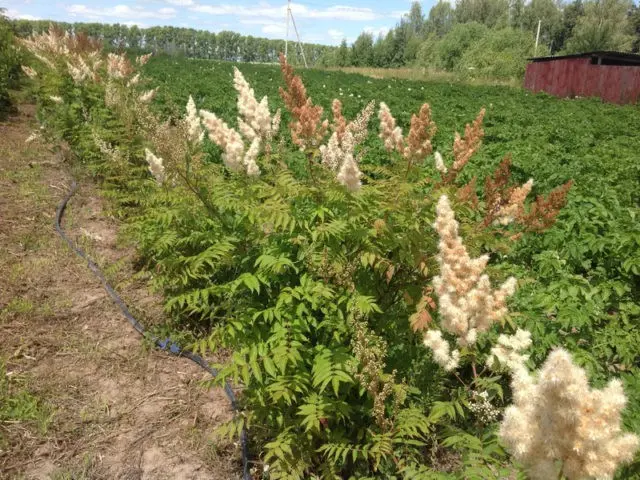
Reproduction of fieldfare cuttings
The easiest way to propagate fieldfare from cuttings, even a novice gardener will cope with the task.
- To do this, in the middle of spring, several shoots of 20-25 cm long are cut from an adult shrub, you can take both apical green and already lignified healthy branches.
- The cuttings must be placed for a day in a solution that stimulates root growth, and then planted in small pots with ordinary soil mixed with sand.
- It is also possible to deepen the cuttings directly on temporary open-air school beds, since the fieldfare tolerates any weather well, the chances of successful rooting in the ground are very high.
For the next few weeks, the cuttings will need to be watered regularly. When new green leaves appear on the shoots, the fieldfare can be carefully transferred to a permanent place – the beginning of vegetative growth means that rooting has taken place.
Breed division multiplication
Another simple and effective way to increase the population of fieldfare is the division of the rowan bush. The method is especially convenient in that it allows you to successfully solve 2 tasks at once – propagate the plant and adjust the size of the bush that is already growing on the site.
- The division is usually carried out in the spring, although it is permissible to propagate the plant in the fall.
- The mother bush is dug out of the ground, the rhizome is divided into several parts with a large knife or a sharpened shovel.
- Slices are treated with ash, crushed coal or ordinary brilliant green – this helps prevent decay.
- Prepared delenki are planted in planting pits – they are dug out according to the standard algorithm, in the same way as during the first planting of a mountain ash plant on the site.
The planted parts of the mother bush are abundantly watered and mulched, and then the usual care is taken for the delenki.
Reproduction by layers
Rowan-leaved fieldfare can be propagated on the site with the help of layering – young shoots of a shrub located low to the ground.
- In the spring, 2-3 healthy green shoots are selected, located close to the ground, and bend them close to the ground.
- In the place where the shoots touch the ground, their bark is slightly incised, and then the layers are slightly deepened into the soil, fixed with a wire or staple so that the branches do not straighten.
- The shoots are sprinkled with earth, while leaving the apical part on the surface, and during the summer they take care of the layering in the same way as the main bush.
Layers take root quite quickly, if the procedure is carried out in the spring, then by the beginning of September the shoots will take root. You can separate them and move them to a permanent place both in the fall and at the beginning of next spring.
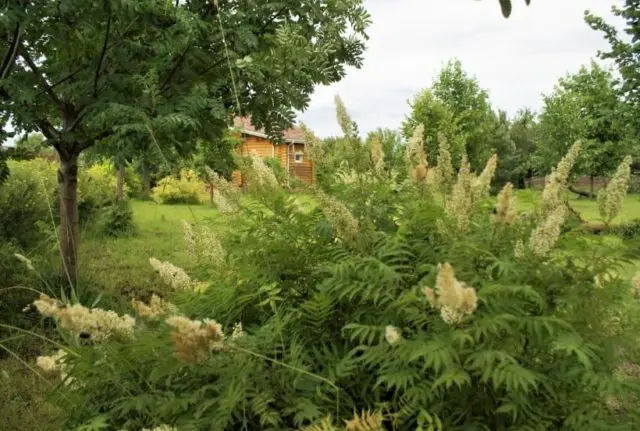
Diseases and pests
In general, fieldfare remains a fairly disease-resistant plant. The most dangerous disease for him is a viral mosaic, with this disease, light green or yellowish patterned stains first appear on the leaves of the plant, and then the foliage is deformed and falls off. Unfortunately, the viral mosaic is practically incurable, if the plant is ill with this disease, then it will have to be destroyed, and then the soil should be carefully treated with disinfectant solutions.
Of the pests, spider mites and green aphids are dangerous for the rowan shrub, although it should be noted that they are quite rare on the leaves of the mountain ash. If insects are found, it is necessary to fight them with insecticidal solutions, such as Fitoverma.
Why the fieldfare does not bloom
Normally, the rowan-leaved fieldfare pleases with flowering every year, even harsh growing conditions do not violate its vegetative cycle. However, for a number of reasons, flowering may not occur or be too modest and inconspicuous.
- First of all, the presence and abundance of flowering depend on the variety and variety of rowan-leaved shrubs. For example, a felt shrub originally from East Asia does not bloom in principle, if just such a plant grows on the site, then decorativeness can not be expected from it.
- The lack of flowering may be due to severely disturbed growing conditions. If the plant grows on too dry soil, does not receive any nutrients and, moreover, is not subjected to regular pruning, its decorative effect may suffer – the mountain ash shrub will have nowhere to get resources for beautiful flowering.
The attractive appearance of fieldfare is greatly spoiled by already faded and dried inflorescences, they do not allow new flowers to develop and reduce decorative effect. Therefore, it is recommended to remove them without fail.
Conclusion
Planting and caring for fieldfare are not particularly difficult, but the basic rules for growing must be observed. If you regularly water, feed and cut the shrub, then it will delight every year with a beautiful and very abundant white flowering and a pleasant fragrant aroma.









